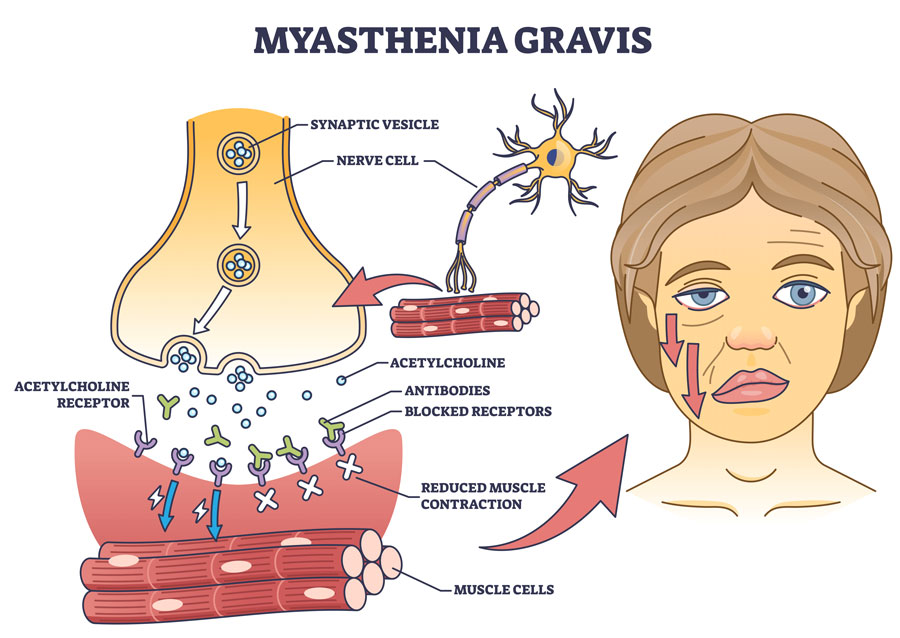
Acupuncture is effective for the treatment of myasthenia gravis. Myasthenia gravis is an neuromuscular autoimmune disorder, characterized by weakness in voluntary muscles. Severity varies and the disease affects breathing, swallowing, limb movements, and facial movements. Researchers at the Air Force Hangzhou Special Service Recuperation Center conducted a clinical study to compare the efficacy of conventional biomedicine to warm needle acupuncture. The study shows that warm needle acupuncture resuls in superior patient responses, indicating its potential as a more beneficial approach in managing myasthenia gravis. [1]
The study employed diverse observational parameters encompassing inflammatory factors including interleukin-6 (IL-6), interleukin-18 (IL-18), interleukin-27 (IL-27), transforming growth factor-β1 (TGF-β1), complements C3 and C4, acetylcholine receptor antibodies (AchR-Ab), and immune function markers (CD4+/CD8+, CD4+ T cells, and CD3+ T cells). The 15-item myasthenia gravis quality of life (MG-QOL 15) scale score and absolute score of myasthenia gravis (ASMG) were also gathered and documented. Explore the antiinflammatory effects of Chinese medicine and get your acupuncture CEUs online at HealthCMi.
Between January 2020 and January 2022, a total of 92 individuals diagnosed with myasthenia gravis were enrolled in the study. These participants were randomly assigned to either the routine pharmaceutical control group or the warm needle acupuncture group, each comprising 46 patients. In the control group, patients ages ranged from 32–73 years, with a mean age of 45 ±5 years. The duration of the condition spanned from 1–9 years, with an average course duration of 3.64 ±0.53 years. Among them, 25 cases exhibited unilateral ptosis and 21 cases presented bilateral ptosis. In the warm needle acupuncture group, patient age ranged from 31–74 years, with a mean age of 44 ±6 years. The duration of the condition varied from 1–8 years, with an average course duration of 4.05 ±0.61 years. Among this group, 24 cases demonstrated unilateral ptosis and 22 cases manifested bilateral ptosis.
Following treatment, both groups exhibited reductions in serum levels of IL-6, IL-18, and IL-27, with significantly lower levels observed in the warm needle acupuncture group compared to the control group. Improvements in serum levels of TGF-β1 and AchR-Ab were noted in both groups post-treatment. Superior enhancements were observed in the warm needle acupuncture group compared to the control group, demonstrating statistical significance.
Increases in complements C3 and C4 were observed after treatment in both groups prior to treatment. Notably, immune function indicators displayed decreased levels after treatment, showcasing significantly lower values in the acupuncture observation group compared with the biomedicine monotherapy control group. Both the MG-QOL 15 scale score and ASMG exhibited declines post-treatment in both groups, with statistically significant lower scores observed in the observation group compared to the control group. Ultimately, the warm needle acupuncture group achieved a total effective rate of 93.5%, surpassing the 73.9% rate observed in the biomedicine group.
The results underscore a consistent finding across numerous studies. Acupuncture has the distinct capability of lowering pro-inflammatory cytokines in patients with chronic illness. In addition, the anti-inflammatory capabilities of acupuncture do not have the adverse effects associated with chronic steriod use, making acupuncture a safe and effective treatment modality for chronic automimmune disorders.
The biomedicine control cohort received a regimen comprising 60 mg of pyridostigmine administered every four hours along with a daily intake of 60 mg of prednisone. Pyridostigmine is a cholinergic muscle stimulant that is used for the treatment of myasthenia gravis and affects nerve communication impulses and muscle movements.
Individual adjustments to the prednisone (a corticosteroid) were made in accordance with the patients' specific conditions. Typically, upon observing the onset of therapeutic effects, a decrement of 5 mg occurred biweekly until the dosage reached a range of 2–5 mg. This therapeutic protocol persisted for a duration of 4 weeks.
In the warm needle acupuncture group, needling stimulation was administered at the specific acupoints as follows:
- ST36 (Zusanli)
- LI4 (Hegu)
- ST40 (Fenglong)
- SP6 (Sanyinjiao)
- SP10 (Xuehai)
- CV6 (Qihai)
For individuals presenting with diarrhea, CV12 (Zhongwan) was additionally targeted. ST28 (Shuidao) was included for patients experiencing excessive perspiration, while BL40 (Weishong) was integrated for those exhibiting walking impairment. Patients were positioned supine during the procedure. A mild reinforcing-attenuating needling technique was employed to elicit the sensation of deqi. Subsequently, moxibustion (2 cm) was applied to the needle handles. Each treatment session lasted 30 minutes and was conducted daily for five consecutive days per week, adhered to over a four-week period.
The result clearly demonstrate both subjective and objective parameters showing significant outcomes for patients receiving acupuncture. At HealthCMi, we would like to see additional research with a third arm for severe cases using an integrated approach of acupuncture, Chinese herbal medicine, and pharmaceutical interventions as needed.
Acceptance of Acupuncture
In China, the therapeutic regimen of 20 acupuncture treatments used in this study is understood as a course of care and one that may require repetition for flare-ups. In the USA and other areas, this understanding is not widespread given that patients have habituated to annual follow-ups with their doctors and only the use of routine medications, not routine office visits, is standard. Overcoming this cultural barrier in medicine is paramount to the treatment of myasthenia gravis worldwide.
Reference:
[1] Zhou Fang, Wu Bin, Wang Yanwei, Jia Wei, Fan Xiaoxia, Liang Ming, etc., Therapeutic Observation Of Needle-warming Moxibustion in Treating Myasthenia Gravis and the Effects on Inflammatory Factors and Immune Function.


